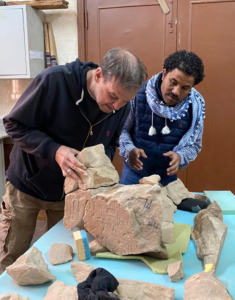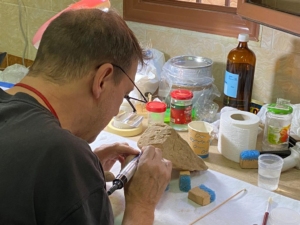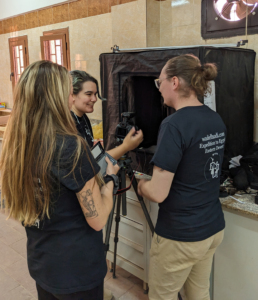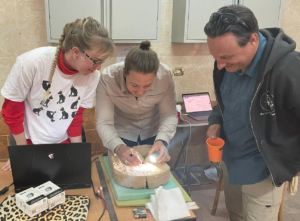- EraMiddle Kingdom
- Project DirectorKate Liszka, Meredith Brand, and Bryan Kraemer
- LocationWadi el-Hudi
- AffiliationCalifornia State University San Bernardino
- Project SponsorAntiquities Endowment Fund
- Project dates: 2022 - 2023
Written by: Kate Liszka and Bryan Kraemer
Wadi el-Hudi is a region in Egypt’s Eastern Desert where pharaohs of the Middle Kingdom sent large expeditions to mine amethyst to be made into jewelry and other prestigious objects. These expeditions often involved over 1,000 workers and over 100 soldiers, both of whom were overseen by dozens of officials tasked with organizing and carrying out these intricate and difficult expeditions.
Many of these officials of the Middle Kingdom chose to erect formal inscriptions about their successes in the desert; these inscriptions often mentioned the pharaoh’s name and/or the year of the expeditions. They frequently placed these stelae in locations of high visibility and foot-traffic so that workers and soldiers would recognize them as signs of authority. At places like Sites 5 and 6, where boulders are prevalent and incorporated into the organization of the site, dozens of inscriptions were carved directly onto the rocks and are still parts of the landscape of Wadi el-Hudi. At places like Sites 4 and 9, that do not have natural boulders, inscriptions were carved onto stone stelae and erected within stela emplacements. These stelae could either be engraved on site using local stones, or they could be carved on limestone, sandstone, or granite in the Nile Valley and brought out to Wadi el-Hudi.
Because of their size and moderate level of portability, the stelae of Sites 4 and 9 have always been in most danger of being reused, damaged, or stolen. For this reason the Egyptian Antiquities Service brought 41 stelae to the Aswan Museum and 3 others to the Cairo Museum for protection in the 1930s. Since the Wadi el-Hudi Expedition started our survey in 2014, we have discovered more stelae and stelae fragments in various locations, but especially at Site 4, the most secluded of all the Wadi el-Hudi sites.
The stelae that we have found have unfortunately often been in poor condition or smashed into many pieces. For example, stela WH254 was reused as a grinding stone, obliterating the central part of the inscription. WH272 is one of the saddest cases of destruction (Figure 1). It is a red granite stela that perhaps once had an extensive biographical text carved onto it. Yet this stela was smashed into 100 pieces likely as recently as 2013, based on GoogleEarth imagery from before then and the fact that all the breaks of the shattered stela are still clean and sharp. In two other cases, our team discovered several pieces of two stelae that connect to other pieces that the Antiquities Service brought to the Aswan Museum in the 1930s (Figure 2). All of these objects needed substantial care and attention to address their damage.

Upon examination of these stelae fragments in our last season, conservator Dr. Erico Peintner, assessed that some fragments had serious damage from salt efflorescence and encrustation while others were suffering from soil deposits of dirt, clay or insect and bird excrement that resulted in acidic staining (Figure 3).

Some of the sandstone fragments of WH22 and WH23 also had been deteriorated by wind erosion. Many pieces no longer fit together like flush puzzle pieces. Fortunately, with the help of the Antiquities Endowment Fund, the American Research Center in Egypt gave us the opportunity to address the growing problem to conserve, restore, record in 3D, and study these weathering stelae.
In the winter of 2022-2023, Dr. Peintner worked hand-in-hand with the epigraphy team first to reassemble each of these stelae, a process in which they needed to match the breaks and see whether the reassembled inscriptions would translate plausibly. This process was easier for some stelae than others. To help with this process, we built large sandboxes in the lab to assemble all the pieces in the right place before they were glued together (Figure 3).
After each piece was cleaned and conserved, our photography and 3D modelling team took over (Figure 4). Bryan Kraemer, Will Feltz, Michael Kraemer, Joana Pinto, and Victoria Shakespeare photographed each fragment from dozens of angles in order to make individual 3D models.

The lighting for each photograph needed to be consistent; then the photos were color corrected, aligned, and turned into the individual 3D models, using Agisoft Metashape software. The 3D models of each fragment were imported into Blender to create a proposed digital 3D reconstruction (Figure 5). Only once all connected fragments were 3D scanned in this way, the physical pieces would be glued together. When the stelae were fully reconstructed, they were stored in individually constructed, long term storage boxes with foam padding and cloth.
Also after a stela’s reconstruction, a second ortho-mosaic was made from a 3D model to use as the base for 3D epigraphic recording. Our 3D epigraphy team—made up of Bryan Kraemer, Amy Wilson, and Ariel Singer—drew each stela in Blender using the Grease-Pencil tool to create a fully 3D-enabled epigraphic drawing (Figure 6).

Epigraphy in 3D is essential because the stelae are not flat; for a drawing to be correct, it must take into account the curves of the stones. Additionally, it is essential to draw these stelae while looking at the original so that the team member can examine and record each scratch on the object. The epigraphy team would collate and debate various possible translations of every sign during this meticulous study. Making 3D models also allows for faster digital publication on Sketchfab, our website, and other places.
This process yielded many exciting insights into the past that we discuss in our article “Reconstructing Stories from Stelae at Wadi el-Hudi” in ARCE’s Scribe magazine. The Stela of Usersatet is particularly significant because it is dedicated to the goddesses Hathor and Satet in a possible temple at Wadi el-Hudi (Figure 5).
Moreover, it is the only New Kingdom object (including pottery) from the entire region of Wadi el-Hudi. We are now requesting the Ministry of Antiquities to consider this stela for display in a museum, so that we can share its exciting look into the past with the world.
We would sincerely like to thank the Egyptian Ministry of Tourism and Antiquities for allowing us to complete this important work, especially Mr. Ahmed Issa, Dr. Mostafa Waziry, Dr. Nashwa Gaber, Dr. Abdul Minhem, Hany Saleh, Shazley Ali Abd Elaziem, Zeinab Gharib, Sayed el-Rawy, Ayman el-Baghdady, and all of our friends and colleagues in the Aswan Magazine and Inspectorate.
We are also grateful to the American Research Center in Egypt and the committee of the Antiquities Endowment Fund, especially Mary Sadek, Mariam Foum, and Louise Bertini. We want to thank our entire conservation and epigraphy team led by Bryan Kraemer, including Erico Peintner, Amy Wilson, Ariel Singer, Will Feltz, Michael Kraemer, Brooke Norton, Joana Pinto, Parker Anderson, and Victoria Shakespeare. And lastly, we want to thank all of people who support our work in Egypt, especially Omer Farouk Sayed, Moatez Sayed, Hamada Adel Farouk, Farouk Ali Farouk, and many others.